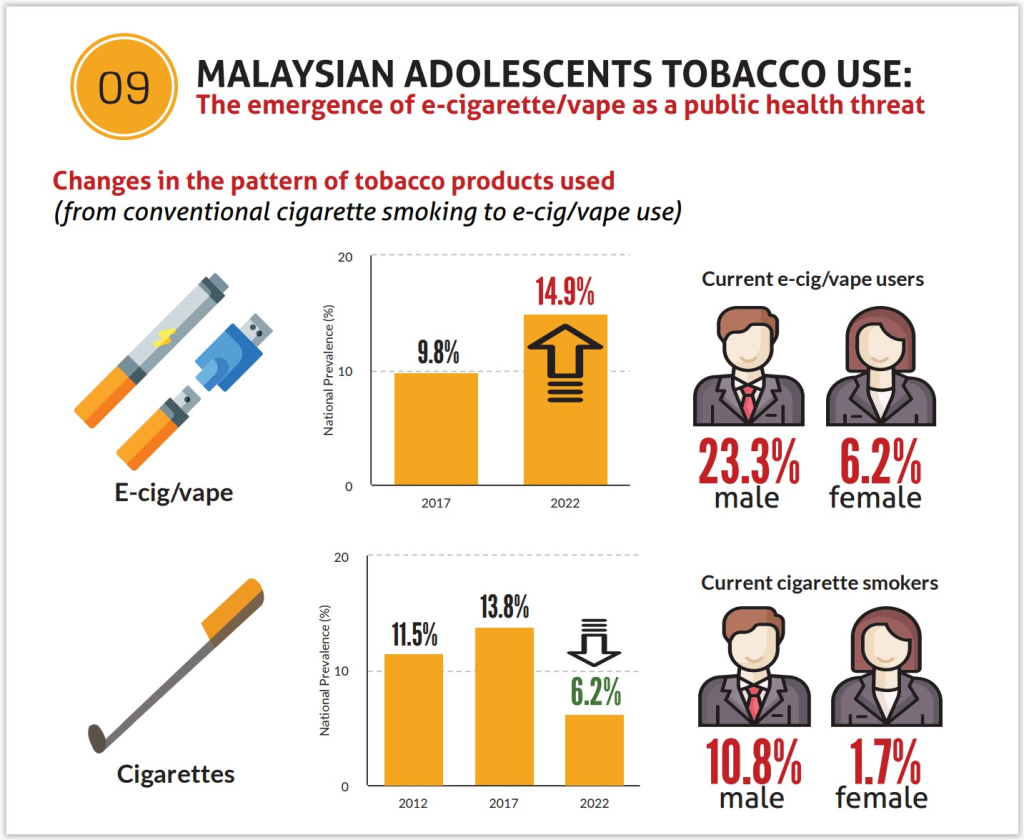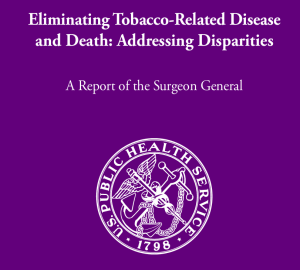According to NHMS Survey 2022, e-cigarette and vape use among Malaysian teens aged 13-17 rose from 9.8% in 2017 to 14.9% in 2022, while cigarette smoking rates in this group dropped from 13.8% to 6.2%. Teen vaping prevalence: 23.3% (male), 6.2% (female).

KUALA LUMPUR, May 25 – The latest data from the National Health and Morbidity Survey (NHMS) 2022 has revealed a significant increase in the prevalence of e-cigarette and vape use among Malaysian teenagers, accompanied by a decline in the rate of smoking.
The findings from the NHMS’ Adolescent Health Survey 2022 suggest a notable shift in tobacco consumption trends in the teenage population in Malaysia aged below 18, with the Ministry of Health (MOH) describing the emergence of e-cigarettes and vape as a “public health threat”.
According to the survey by the Institute for Public Health, National Institutes of Health, at the MOH, the prevalence of teenagers aged 13 to 17 years currently using e-cigarettes or vape rose from 9.8 per cent in 2017 to 14.9 per cent in 2022, marking a notable increase over the five-year period.
The data further reveals that a higher proportion of adolescent males (23.3 per cent) currently engaged in vaping in 2022, compared to females (6.2 per cent).
In contrast, the prevalence of cigarette smoking among Malaysian teenagers has witnessed a decline. The NHMS survey shows that the rate of current cigarette use among adolescents aged 13 to 17 dropped from 13.8 per cent in 2017 to 6.2 per cent in 2022.
By gender, 10.8 per cent of adolescent males currently smoked cigarettes in 2022, compared to 1.7 per cent of adolescent females.
This indicates that about twice as many teenage males in Malaysia vape compared to smoking cigarettes, while vaping is nearly four times more common than smoking cigarettes among teenage females.
The survey findings on a simultaneous increase in vaping and decline in smoking also suggest that Malaysian adolescents may be swapping cigarettes for vape.
The NHMS survey explored the sources from which teenagers obtain tobacco products. The data indicated that 35.7 per cent of teenagers obtained tobacco products from shops, while a similar percentage, 34.6 per cent, acquired them from dedicated vape stores. Additionally, 34.8 per cent of respondents reported obtaining tobacco products from friends.
NHMS’ sampling for its Adolescent Health Survey 2022 was among secondary school students in Malaysia aged 13 to 17 years.
These findings underscore the importance of regulating access to tobacco products, both in traditional and specialised retail settings, as well as the need for comprehensive strategies to address peer-to-peer distribution.
Efforts to restrict underage access to these products may need to be reinforced, including stricter enforcement of age verification protocols in retail establishments.
Although current tobacco regulations prohibit the sale of cigarettes and other tobacco products to those aged below 18, there are no regulations on e-cigarette and vape products with nicotine that are now legally accessible to everyone, including minors, after the government removed liquid nicotine from the Poisons Act 1952 to enable taxation on e-liquids with nicotine.
Health Minister Dr Zaliha Mustafa has promised to table the Control of Smoking Product for Public Health Bill 2023 next month during the current parliamentary meeting, should Cabinet approve the bill in its meeting tomorrow.
Source: Code Blue










